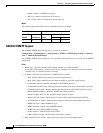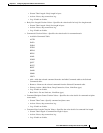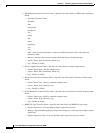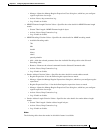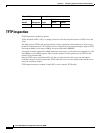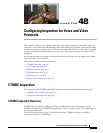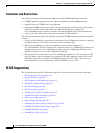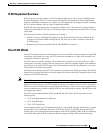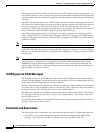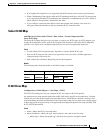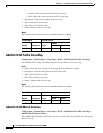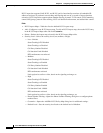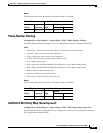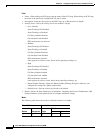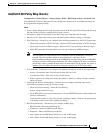
48-4
Cisco ASA 5500 Series Configuration Guide using ASDM
Chapter 48 Configuring Inspection for Voice and Video Protocols
H.323 Inspection
After inspecting the H.225 messages, the ASA opens the H.245 channel and then inspects traffic sent
over the H.245 channel as well. All H.245 messages passing through the ASA undergo H.245 application
inspection, which translates embedded IP addresses and opens the media channels negotiated in H.245
messages.
The H.323 ITU standard requires that a TPKT header, defining the length of the message, precede the
H.225 and H.245, before being passed on to the reliable connection. Because the TPKT header does not
necessarily need to be sent in the same TCP packet as H.225 and H.245 messages, the ASA must
remember the TPKT length to process and decode the messages properly. For each connection, the ASA
keeps a record that contains the TPKT length for the next expected message.
If the ASA needs to perform NAT on IP addresses in messages, it changes the checksum, the UUIE
length, and the TPKT, if it is included in the TCP packet with the H.225 message. If the TPKT is sent in
a separate TCP packet, the ASA proxy ACKs that TPKT and appends a new TPKT to the H.245 message
with the new length.
Note The ASA does not support TCP options in the Proxy ACK for the TPKT.
Each UDP connection with a packet going through H.323 inspection is marked as an H.323 connection
and times out with the H.323 timeout as configured in the Configuration > Firewall > Advanced > Global
Timeouts pane.
Note You can enable call setup between H.323 endpoints when the Gatekeeper is inside the network. The ASA
includes options to open pinholes for calls based on the RegistrationRequest/RegistrationConfirm
(RRQ/RCF) messages. Because these RRQ/RCF messages are sent to and from the Gatekeeper, the
calling endpoint's IP address is unknown and the ASA opens a pinhole through source IP address/port
0/0. By default, this option is disabled.
H.239 Support in H.245 Messages
The ASA sits between two H.323 endpoints. When the two H.323 endpoints set up a telepresentation
session so that the endpoints can send and receive a data presentation, such as spreadsheet data, the ASA
ensure successful H.239 negotiation between the endpoints.
H.239 is a standar that provides the ability for H.300 series endpoints to open an additional video channel
in a single call. In a call, an endpoint (such as a video phone), sends a channel for video and a channel
for data presentation. The H.239 negotiation occurs on the H.245 channel.
The ASA opens pinholes for the additional media channel and the media control channel. The endpoints
use open logical channel message (OLC) to signal a new channel creation. The message extension is
part of H.245 version 13.
The decoding and encoding of of the telepresentation session is enabled by default. H.239 encoding and
decoding is preformed by ASN.1 coder.
Limitations and Restrictions
The following are some of the known issues and limitations when using H.323 application inspection:
• Static PAT may not properly translate IP addresses embedded in optional fields within H.323
messages. If you experience this kind of problem, do not use static PAT with H.323.



